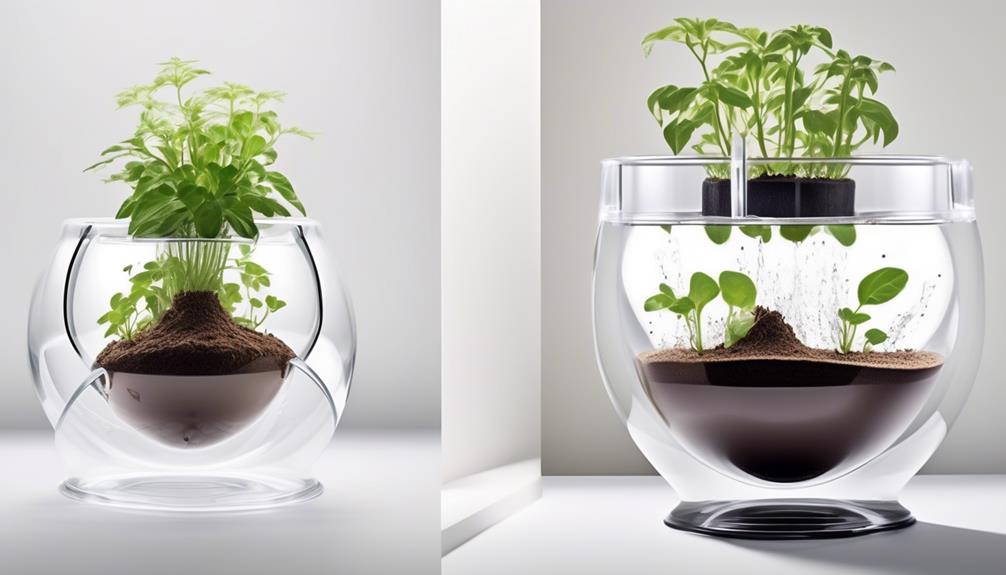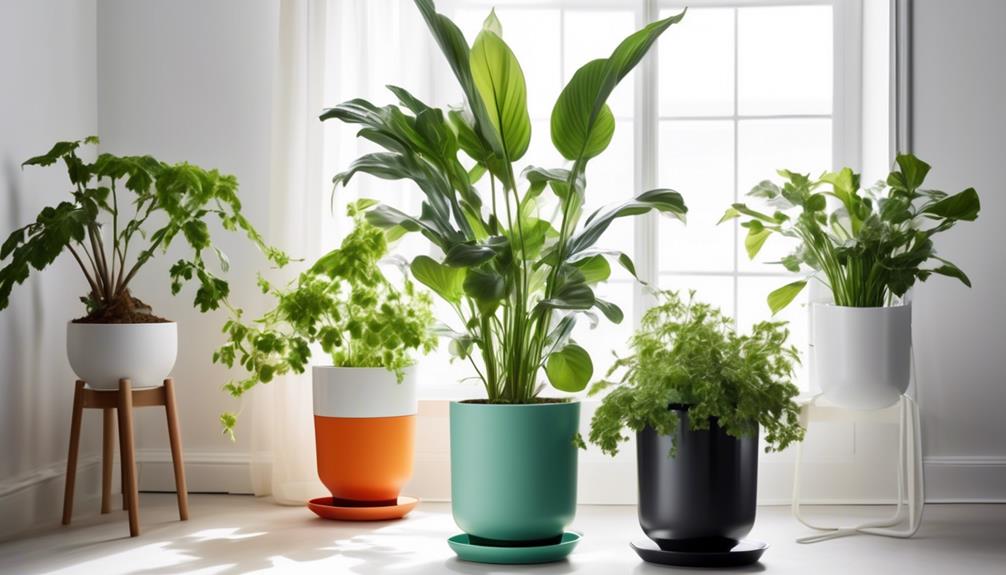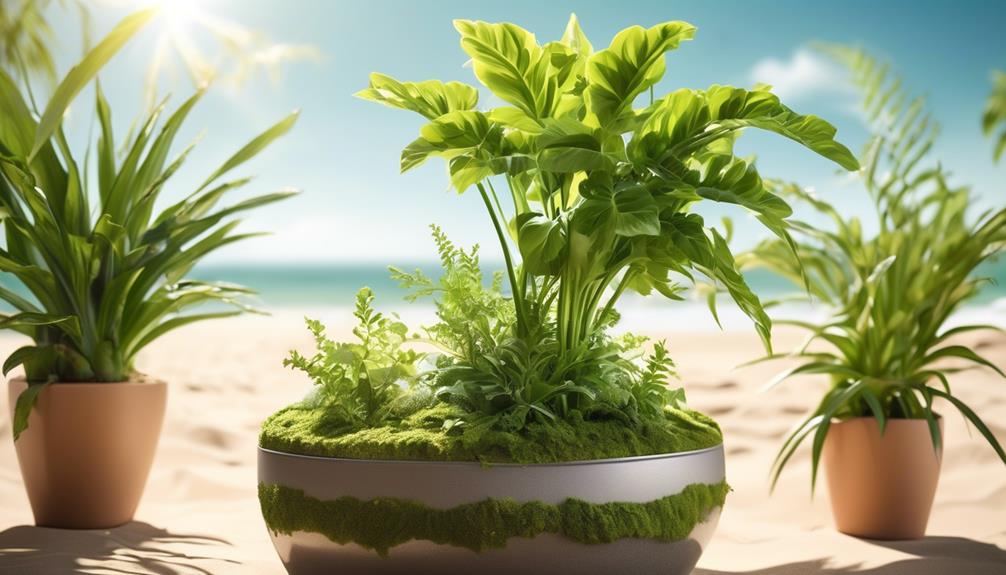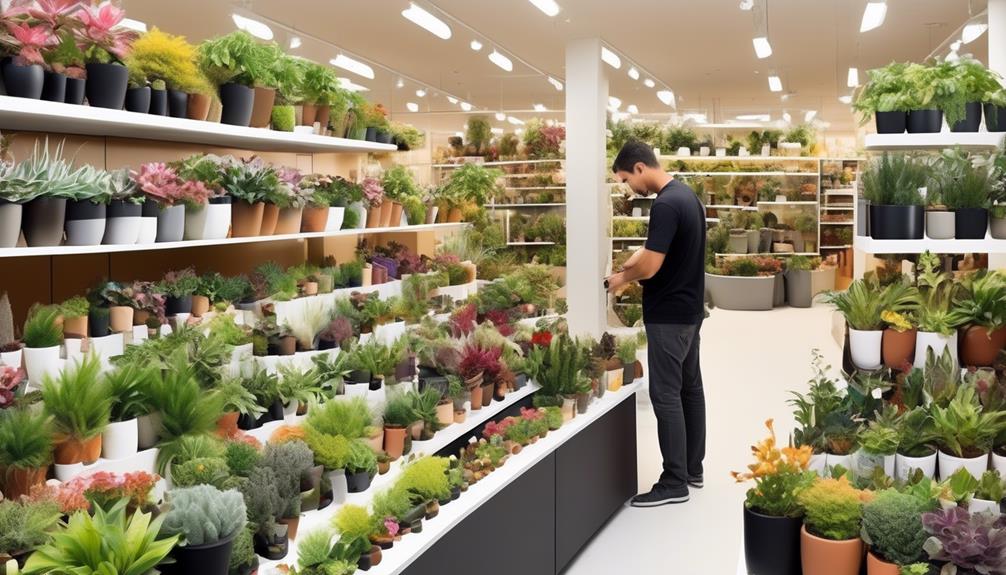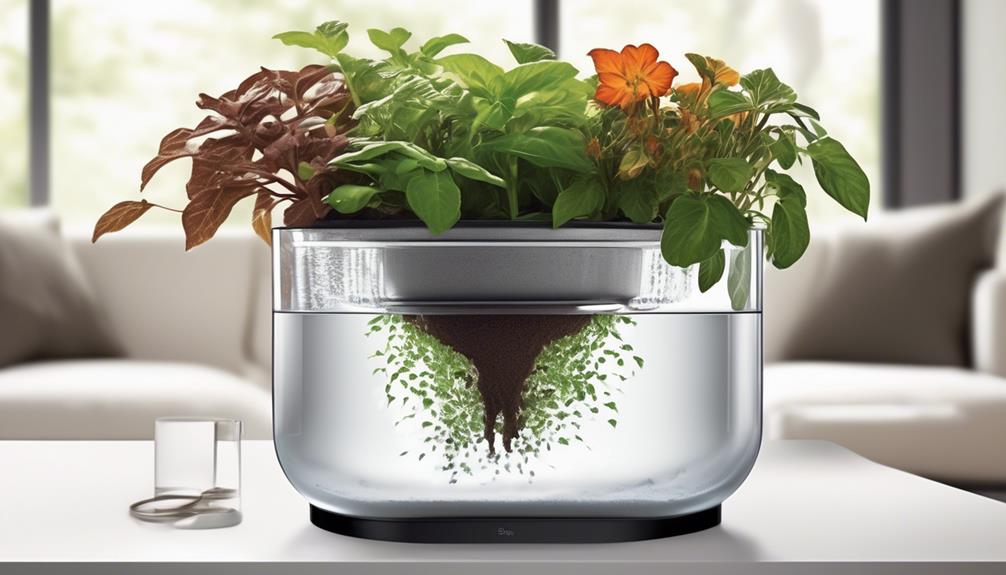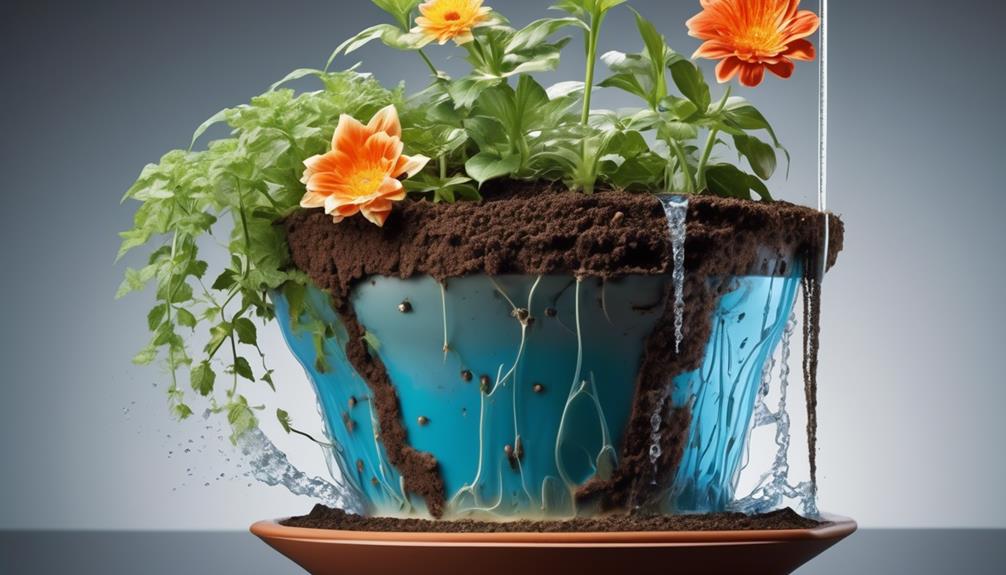Self-watering planters function like a reliable companion who instinctively understands when help is needed.
But have you ever wondered how they manage to keep your plants perfectly hydrated without constant attention? Well, let's just say there's more to it than meets the eye.
The inner workings of these pots are a fascinating blend of science and design, and understanding how they operate can shed light on their remarkable efficiency.
Key Takeaways
- Self-watering plant pots have a water reservoir that prevents waterlogging and ensures efficient plant care.
- Capillary action and a wicking system facilitate water absorption and transport it from the reservoir to the plant roots.
- The use of high-quality materials in the construction of self-watering pots is essential for their effectiveness.
- Soil moisture regulation through capillary action and osmosis helps maintain consistent moisture levels, promoting healthy plant growth.
The Components of Self-Watering Plant Pots
In self-watering plant pots, the components consist of a water reservoir, a wicking system, and a growing medium, all working together to provide a continuous and balanced supply of moisture to the plant.
The water reservoir, typically located at the base of the pot, stores the excess water, preventing waterlogging. This reservoir is designed with materials that inhibit the growth of mold and algae, ensuring the purity of the water.
The wicking system, usually made of porous materials like cotton or nylon, facilitates water absorption from the reservoir to the growing medium. This capillary action allows water to move upwards, ensuring that the plant's roots receive the necessary moisture.
The growing medium, often a blend of peat, coconut coir, and vermiculite, provides structural support for the plant and aids in water retention.
The material construction of these components is crucial, as it directly impacts the efficiency of the self-watering system. By utilizing high-quality, durable materials, self-watering plant pots can serve the needs of the plant and the individual caring for it effectively.
The Capillary Action Process
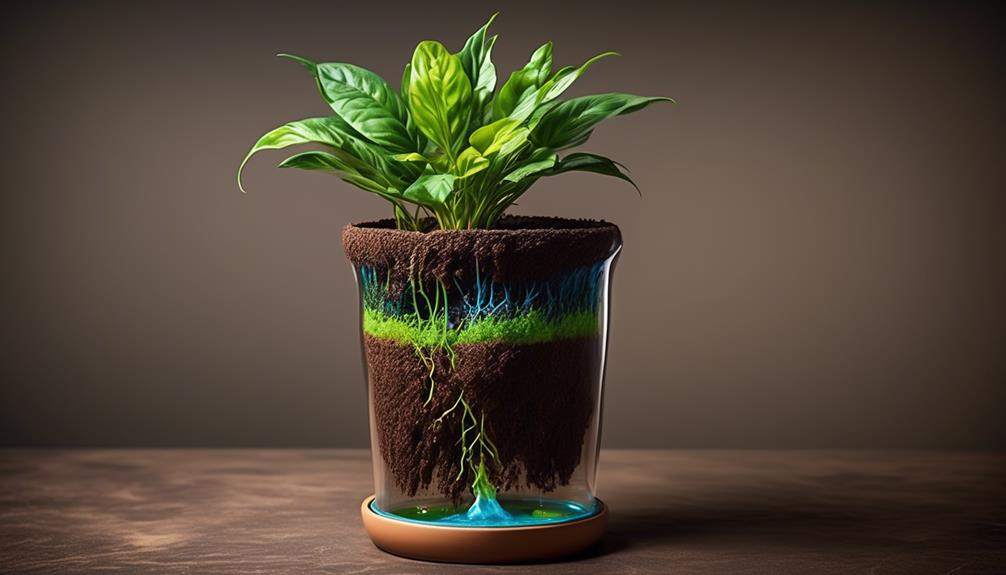
The capillary action process functions as a critical mechanism in self-watering plant pots, enabling the upward movement of water from the reservoir to the growing medium through porous materials. Capillary action, also known as capillarity, occurs due to the cohesive and adhesive properties of water. When a porous material, such as soil or a wick, is in contact with water, the water is drawn upward against the force of gravity. This process is essential for the consistent hydration of plants in self-watering pots.
- Capillary Action: This process relies on the ability of water to move through narrow spaces, such as the tiny gaps in soil or the fibers of a wick, due to cohesive and adhesive forces.
- Water Absorption: Porous materials like soil or fabric act as mediums for water absorption, allowing it to move upwards to hydrate the plant roots.
- Hydration Mechanism: Through capillary action, water is transported from the reservoir to the plant roots, ensuring a continuous supply of moisture for healthy growth.
Understanding the capillary action process is crucial for effectively utilizing self-watering plant pots to maintain optimal moisture levels for plants, making it a valuable concept for gardening enthusiasts.
How the Water Reservoir Functions
Operating on the principle of osmosis, the water reservoir in self-watering plant pots consistently supplies moisture to the growing medium. The water absorption process begins when the soil becomes dry, creating a gradient that draws water from the reservoir into the soil. This is facilitated by the semi-permeable membrane present in the self-watering pot, allowing water to move from an area of higher concentration (the reservoir) to an area of lower concentration (the soil).
As the soil absorbs water, gravity assists in the flow of moisture downwards, ensuring that the entire root system receives the necessary hydration. This gravity flow is crucial in evenly distributing moisture throughout the growing medium, preventing waterlogging at the top and ensuring that the lower roots also receive the required water supply.
Understanding the Soil Moisture Regulation
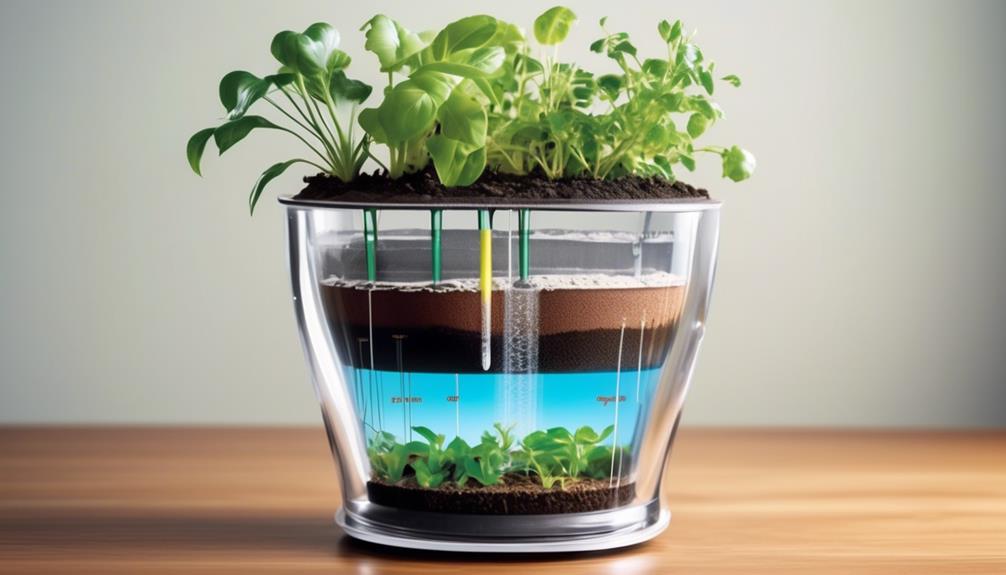
Harnessing the principles of osmosis and gravity flow, the self-watering plant pots' water reservoir efficiently regulates soil moisture to ensure healthy plant growth. In this system, the soil moisture regulation is achieved through a combination of physical and biological processes, ensuring optimal plant hydration and reducing the risk of over or under-watering.
- Capillary Action: The self-watering pots utilize capillary action to draw water from the reservoir into the soil. This process allows the soil to maintain consistent moisture levels, ensuring that the plant roots have access to water as needed.
- Osmotic Pressure: Osmosis plays a vital role in regulating soil moisture within the self-watering pots. By creating a semi-permeable barrier between the water reservoir and the soil, osmotic pressure allows for the gradual release of water into the soil, maintaining a balanced level of moisture for plant hydration.
- Root Uptake: The design of the self-watering pots encourages natural root uptake of water. As the soil maintains optimal moisture levels, the plant roots can efficiently absorb water and essential nutrients, promoting healthy growth and vitality.
Benefits and Best Practices for Use
To maximize the benefits of self-watering plant pots, it is essential to adhere to best practices for their optimal utilization. These pots offer several advantages, including consistent moisture levels, reduced water wastage, and improved plant health. However, to achieve these benefits, proper maintenance and usage are crucial. Here are some maintenance tips and best practices for using self-watering plant pots:
| Maintenance Tips and Best Practices | Description |
|---|---|
| Use the right soil | Choose a well-draining potting mix specifically designed for self-watering pots to prevent waterlogging and root rot. |
| Regularly check the water level | Monitor the water reservoir to ensure it is adequately filled, especially during hot weather or when the plants are actively growing. |
| Clean the watering system | Periodically clean the watering mechanism to prevent clogs and algae growth, ensuring the system functions properly. |
| Avoid over-fertilizing | Self-watering pots may require less frequent fertilization due to the efficient use of nutrients. Over-fertilizing can lead to salt buildup and damage the plants. |
| Provide adequate ventilation | While self-watering pots reduce the frequency of watering, proper ventilation is still essential to prevent mold and mildew growth. |
Frequently Asked Questions
Can Self-Watering Plant Pots Be Used for All Types of Plants, Including Succulents and Cacti?
Absolutely, self-watering pots can be used for succulents and cacti. They require less frequent watering than other plants, and self-watering pots can help maintain the right moisture levels.
Succulent care involves allowing the soil to dry out between waterings, and self-watering pots can help achieve this by providing a consistent moisture level without overwatering.
It's essential to choose a self-watering pot with good drainage to prevent waterlogging for these types of plants.
Is It Possible to Overwater Plants in Self-Watering Pots, and How Can This Be Avoided?
Absolutely, it's crucial to avoid overwatering plants in self-watering pots to prevent root rot and other issues.
Best watering practices involve monitoring the soil moisture and adjusting the watering frequency based on the plant's needs.
It's essential to strike the right balance, ensuring the plant gets enough water without becoming waterlogged.
Are Self-Watering Pots Suitable for Outdoor Use in Different Weather Conditions?
Self-watering pots are suitable for outdoor use in various weather conditions due to their outdoor durability and weather resistance. These pots are designed to withstand exposure to the elements, making them ideal for outdoor settings.
The materials used in their construction are often chosen for their ability to resist fading, cracking, and other types of damage caused by sun, rain, and extreme temperatures. This ensures that the pots can effectively serve the needs of outdoor plants.
Can Self-Watering Pots Be Used With Fertilizer, and if So, How Often Should It Be Added?
Using fertilizers in self-watering pots can be beneficial. However, we need to be cautious about over-fertilization, which can lead to root rot. It's important to dilute the fertilizer and add it to the water reservoir.
The watering frequency should be adjusted based on the plant's needs and the fertilizer used. Always ensure that the pots have a good drainage system to prevent waterlogging and nutrient buildup.
What Are the Potential Drawbacks or Limitations of Using Self-Watering Plant Pots?
Well, self-watering plant pots offer convenience, but there are limitations.
Maintenance requirements can be higher as the water reservoir needs frequent refilling, especially in hot and dry conditions.
Additionally, overwatering can be a concern, leading to root rot. It's important to monitor the soil moisture regularly to avoid waterlogging.
Understanding these limitations and managing maintenance effectively can help maximize the benefits of self-watering plant pots.
Can I Use Self-Watering Plant Pots for Indoor and Outdoor Plants?
Yes, you can use a self watering plant pot for both indoor and outdoor plants. These pots are designed to provide a consistent supply of water to the plants, making them perfect for busy individuals or those who may forget to water their plants regularly.
Conclusion
In conclusion, self-watering plant pots operate through a fascinating combination of capillary action, water reservoirs, and soil moisture regulation. The intricate process ensures that your plants receive the right amount of water at all times, resulting in healthy and thriving greenery.
By understanding the components and benefits of these pots, you can elevate your gardening experience and enjoy the convenience of efficient plant care.
Explore the world of self-watering plant pots and watch your garden flourish like never before.

